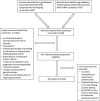Survival, morbidity, growth and developmental delay for babies born preterm in low and middle income countries - a systematic review of outcomes measured
- PMID: 25793703
- PMCID: PMC4368095
- DOI: 10.1371/journal.pone.0120566
Survival, morbidity, growth and developmental delay for babies born preterm in low and middle income countries - a systematic review of outcomes measured
Abstract
Background: Premature birth is the leading cause of neonatal death and second leading in children under 5. Information on outcomes of preterm babies surviving the early neonatal period is sparse although it is considered a major determinant of immediate and long-term morbidity.
Methods: Systematic review of studies reporting outcomes for preterm babies in low and middle income settings was conducted using electronic databases, citation tracking, expert recommendations and "grey literature". Reviewers screened titles, abstracts and articles. Data was extracted using inclusion and exclusion criteria, study site and facilities, assessment methods and outcomes of mortality, morbidity, growth and development. The Child Health Epidemiology Reference Group criteria (CHERG) were used to assess quality.
Findings: Of 197 eligible publications, few (10.7%) were high quality (CHERG). The majority (83.3%) report on the outcome of a sample of preterm babies at time of birth or admission. Only 16.0% studies report population-based data using standardised mortality definitions. In 50.5% of studies, gestational age assessment method was unclear. Only 15.8% followed-up infants for 2 years or more. Growth was reported using standardised definitions but recommended morbidity definitions were rarely used. The criteria for assessment of neurodevelopmental outcomes was variable with few standardised tools - Bayley II was used in approximately 33% of studies, few studies undertook sensory assessments.
Conclusions: To determine the relative contribution of preterm birth to the burden of disease in children and to inform the planning of healthcare interventions to address this burden, a renewed understanding of the assessment and documentation of outcomes for babies born preterm is needed. More studies assessing outcomes for preterm babies who survive the immediate newborn period are needed. More consistent use of data is vital with clear and aligned definitions of health outcomes in newborn (preterm or term) and intervention packages aimed to save lives and improve health.
Conflict of interest statement
Figures
References
-
- WHO (2013) World Health Statistics 2013. Geneva: World Health Organization; Available at: http://www.who.int/gho/publications/world_health_statistics/2013/en/
-
- Blencowe H, Cousens S, Oestergaard MZ, Chou D, Moller AB, Narwal R, et al. National, regional, and worldwide estimates of preterm birth rates in the year 2010 with time trends since 1990 for selected countries: a systematic analysis and implications. Lancet. 2012;379:2162–2172. 10.1016/S0140-6736(12)60820-4 - DOI - PubMed
-
- van den Broek NR, White SA, Ntonya C, Ngwale M, Cullinan TR, et al. Reproductive health in rural Malawi: a population-based survey. Brit J Obstet Gynaec. 2013;110:902–908. - PubMed
Publication types
MeSH terms
LinkOut - more resources
Full Text Sources
Other Literature Sources
Medical





